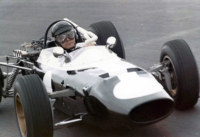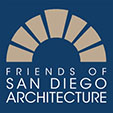By Christa Vragel
As one of San Diego’s premier modernist architects, Henry Hester designed buildings praised as “clean and straight.”
Born May 30, 1925, in Vinita, Oklahoma, Henry moved with his family to San Diego as a youth. He attended Roosevelt Junior High School and Brown Military Academy before serving in the Coast Guard during World War II. In 1947, he graduated from the University of Southern California with a bachelor’s degree in architecture and moved to La Jolla.
“I knew him at USC and he was a talent even then,” said Hal Sadler who leads his own design firm in San Diego. “He was recognized by a group of USC people who came to San Diego as one of the early standouts in design.”
One of Hester’s most notable San Diego designs is the Solomon Apartments on Sixth Avenue across from Balboa Park. In 1958, Col. Irving Salomon commissioned Mr. Hester to design a luxury apartment building with 30 spacious units and a posh penthouse at 3200 Sixth Ave. The one- to three-bedroom units were showcased in a 1960 edition of San Diego Magazine. Selected by Salomon over John Lloyd Wright, the architect-son of the legendary Frank Lloyd Wright, Mr. Hester created an airy and free-flowing atmosphere with floor-to-ceiling doors and windows to take advantage of the views. When the complex opened it was marketed as San Diego’s “Most Distinguished Place to Live.”
Henry Hester also designed numerous single-family homes in La Jolla. An example of his style, an ocean-front residence featured by Dwell, can be seen at the webpage linked below. It is only one instance of how masterful he was at using lighting and windows, and various textures, to emphasize movement and freedom of space.
Early mentors of Hester included William Cody of Palm Springs and San Diego’s own pioneering mid-century modernist, Lloyd Ruocco. Over the years Hester would form partnerships with Fred Liebhardt (in 1957), Ronald K. Davis (1958-1959), William Cody (1958-1960), and Robert E. Jones. His projects, while mainly focused in the San Diego area, extended throughout California and reached as far afield as Denver, Albuquerque, and Florida.
According to the well-known architectural photographer Julius Shulman, Henry Hester’s designs peaked during “a good period of architecture when San Diego was just beginning to express itself in favor of modernism. …in the early years…the International Style was not accepted. …Hester and others warmed up the work quite a bit and edited it in a way that clients would accept.”
In contrast to his designs, Mr. Hester seemed to enjoy keeping a low profile. “He was intensely private,” said his wife Nancy. “He was proud of his custom residences and of being an independent person, his own man…he did it his way.”
During a career spanning four decades, Hester received numerous local and national awards from the American Institute of Architects for his custom single-family homes and his commercial buildings. In 2006, Hester died at the age of 81. He was described by fellow modernist Hal Sadler: “In many ways Henry was an architect’s architect. He loved detail and design. Above all, he was a special guy.”

Henry Hester raced Formula cars nationally, here in ‘Number 5’. He rode motorcycles, held a multi-engine pilot’s license, and enjoyed windsurfing, water-skiing, and dominoes. Hester was also an avid golfer, often frequenting the La Jolla Country Club, Fairbanks Ranch Country Club, and Indian Ridge Country Club in Palm Desert.
Resources:
Borrego Modern: http://www.borregomodern.com/the_design/henry_hester.php
Dwell Media: https://www.dwell.com/home/la-jolla-ocean-front-contemporary-home-by-henry-hester-0ed73c2e
Historical Resources Board (City of San Diego): Biographies of Established Masters, HRB 2011
Obituary: San Diego Union-Tribune, November 2006
Photo credit:
www.modernsandiego.com
